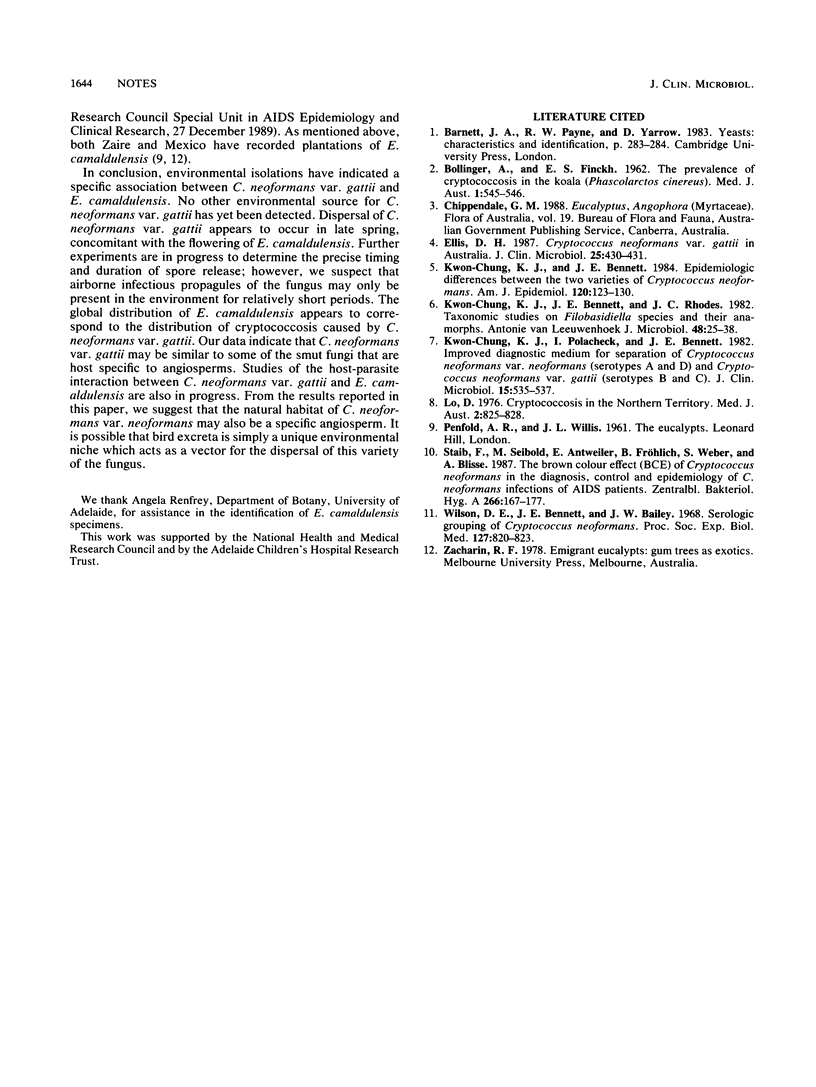Abstract
Environmental isolations have established that Cryptococcus neoformans var. gattii appears to have a specific ecological association with Eucalyptus camaldulensis. So far, we have isolated C. neoformans var. gattii on 35 separate occasions, all from samples associated with E. camaldulensis. The global distribution of E. camaldulensis appears to correspond to the epidemiologic distribution of cryptococcosis caused by C. neoformans var. gattii. No other environmental source for the fungus has yet been detected, and no other eucalypt has the distribution pattern corresponding to reported cases caused by this fungus. These findings may provided an explanation for the high incidence of infections caused by C. neoformans var. gattii in Australian aborigines living in the Northern Territory and for its low worldwide incidence in acquired immunodeficiency syndrome patients.
Full text
PDF


Images in this article
Selected References
These references are in PubMed. This may not be the complete list of references from this article.
- BOLLIGER A., FINCKH E. S. The prevalence of cryptococcosis in the koala (Phascolarctos cinereus). Med J Aust. 1962 Apr 14;49(1):545–547. [PubMed] [Google Scholar]
- Ellis D. H. Cryptococcus neoformans var. gattii in Australia. J Clin Microbiol. 1987 Feb;25(2):430–431. doi: 10.1128/jcm.25.2.430-431.1987. [DOI] [PMC free article] [PubMed] [Google Scholar]
- Kwon-Chung K. J., Bennett J. E. Epidemiologic differences between the two varieties of Cryptococcus neoformans. Am J Epidemiol. 1984 Jul;120(1):123–130. doi: 10.1093/oxfordjournals.aje.a113861. [DOI] [PubMed] [Google Scholar]
- Kwon-Chung K. J., Bennett J. E., Rhodes J. C. Taxonomic studies on Filobasidiella species and their anamorphs. Antonie Van Leeuwenhoek. 1982;48(1):25–38. doi: 10.1007/BF00399484. [DOI] [PubMed] [Google Scholar]
- Kwon-Chung K. J., Polacheck I., Bennett J. E. Improved diagnostic medium for separation of Cryptococcus neoformans var. neoformans (serotypes A and D) and Cryptococcus neoformans var. gattii (serotypes B and C). J Clin Microbiol. 1982 Mar;15(3):535–537. doi: 10.1128/jcm.15.3.535-537.1982. [DOI] [PMC free article] [PubMed] [Google Scholar]
- Lo D. Cryptococcosis in the Northern Territory. Med J Aust. 1976 Nov 27;2(22):825–825,828. doi: 10.5694/j.1326-5377.1976.tb115397.x. [DOI] [PubMed] [Google Scholar]
- Staib F., Seibold M., Antweiler E., Fröhlich B., Weber S., Blisse A. The brown colour effect (BCE) of Cryptococcus neoformans in the diagnosis, control and epidemiology of C. neoformans infections in AIDS patients. Zentralbl Bakteriol Mikrobiol Hyg A. 1987 Aug;266(1-2):167–177. doi: 10.1016/s0176-6724(87)80030-5. [DOI] [PubMed] [Google Scholar]
- Wilson D. E., Bennett J. E., Bailey J. W. Serologic grouping of Cryptococcus neoformans. Proc Soc Exp Biol Med. 1968 Mar;127(3):820–823. doi: 10.3181/00379727-127-32812. [DOI] [PubMed] [Google Scholar]



